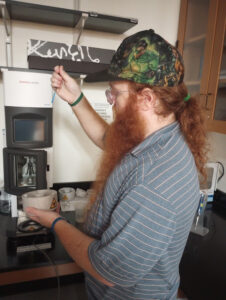
Artificial Intelligence (AI) software is one result.
But the programs are just software. They’re no different than yesterday’s database computing. They’re based on it, true. They run thanks to Nvidia Graphics Processing Units (GPUs), products of Huang’s Law, that crunch numbers fast. This lets you train a giant database to deliver output in a variety of forms.
But it’s still software.
Biotechnology is now trying to get its arms around this. Research requires that students consume immense libraries of research papers and build theories from huge libraries of possible compounds. AI software can summarize the work and model the compounds faster than people. That’s why universities and pharma start-ups are anxious to get this into their labs. (Shown is a scientist in whom I take particular pride.)
But AI software can only make suggestions, after absorbing existing research. People still must do the analysis, and they still must do the experiments. They’re helped by machines made possible by Moore’s Law, like Cryogenetic Electron Microscopes (CryoEM). These make the three dimensions of a molecule visible by freezing it first. But the scientist still must prepare the sample, run it, and analyze results.
AI software also doesn’t provide any shortcuts for teaching biochemistry, although visualizations that make complex concepts obvious are coming, even for high school students. It’s an evolution, not a revolution. It will take a decade to absorb, as programs like Salesforce took a decade to absorb. Once it’s absorbed it will improve scientific productivity and let science teams do more work faster.
Just remember. The software is not the scientist.










